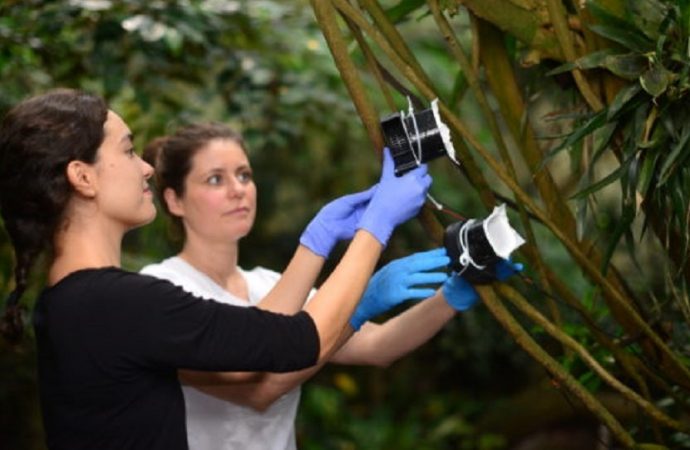Two new studies have shown that environmental DNA can be collected from the air and used to detect a variety of animals, offering what scientists say is a “novel, non-invasive approach” to monitoring biodiversity.
Source: CTV News
Scientists say the findings, which were made by two independent groups of researchers, one based in Denmark, and the other out of the United Kingdom and Canada, could revolutionize the way endangered animals and natural ecosystems are protected.
The two studies were published Thursday in the peer-reviewed scientific journal Current Biology.
To test whether airborne environmental DNA, known as eDNA, could be used to detect terrestrial animal species, both teams of researchers collected air samples from two European zoos –the Hamerton Zoo Park in the U.K., and the Copenhagen Zoo in Denmark.
The studies note that living organisms shed DNA into their surrounding environments as they interact with them.
According to a press release, each group used a different method to filter the eDNA, but both succeeded in being able to detect a wide range of animal species. Interestingly, species within and beyond the confines of the two zoos were detected.
The Danish team collected their air samples using three different devices — a commercial, water-based vacuum and two blower fans with filters attached. They collected the samples in three locations, including the okapi stable, the Rainforest House and outside between the outdoor enclosures.
Kristine Bohmann, associate professor from the Globe Institute at the University of Copenhagen and lead researcher of the Danish study, says her team was “astonished” by the results.
“In just 40 samples, we detected 49 species spanning mammal, bird, amphibian, reptile and fish. In the Rainforest House we even detected the guppies in the pond, the two-toed sloth and the boa,” Bohmann explained in the release. “When sampling air in just one outdoor site, we detected many of the animals with access to an outdoor enclosure in that part of the zoo, for example kea, ostrich and rhino.”
The U.K. study was led by assistant professor Elizabeth Clare from York University in Toronto, who was senior lecturer at Queen Mary University of London at the time of the research.
Clare’s team used filters attached to vacuum pumps to collect more than 70 air samples from different locations around the zoo, both inside animal sleeping areas and outside in the general area.
She says the findings exceeded researchers’ expectations.
“When we analyzed the collected samples, we were able to identify DNA from 25 different species of animals, such as tigers, lemurs and dingoes, 17 of which were known zoo species,” Clare said in the release.
Clare said her team was even able to collect eDNA from animals that were “hundreds of metres away” inside sealed buildings.
“The animals were inside, but their DNA was escaping,” she said.
Some of these animals included the Eurasian hedgehog, which is endangered in the U.K. and was detected from outside of Hamerton Zoo, as well as the water vole and red squirrel which were detected around the Copenhagen Zoo.
According to the press release, both groups of researchers were also able to pick up the presence of food items for the zoo animals in the air, such as chicken, cow, horse and fish.
GLOBAL IMPACT ON CONSERVANCY
Researchers say these findings show that airborne eDNA could be used to potentially detect and monitor animal species in the wild to support global conservation efforts.
“Air sampling could revolutionise terrestrial biomonitoring and provide new opportunities to track the composition of animal communities as well as detect invasion of non-native species,” Clare said in the release.
Because the sampling techniques were not invasive to the animals, Clare said this approach is also valuable for observing endangered species in “hard-to-reach environments, such as caves and burrows.”
“They do not have to be visible for us to know they are in the area if we can pick up traces of their DNA, literally out of thin air,” she said.
However, the studies acknowledge that working with eDNA from the air can be tricky.
“Air is a challenging substrate to work with as air surrounds everything, which means that contamination risk is high. We wanted to ensure that the species we detected were from the zoo and not for example from the lab,” said Christina Lynggaard of the Danish team in the release.
To ensure that there was no contaminant DNA floating in the samples, the Danish researchers also analyzed air from within the lab.
According to the press release, the teams had no knowledge of one another’s work until the studies were completed, but say they are “thrilled by the parallel nature of the experiments.”
The lead researchers agree that having two, separate teams be able to independently demonstrate that airborne eDNA can be used to monitor numerous animal species “greatly enhances the strength of their work and clearly show the potential of the technique.”
“We did not think that vacuuming animal DNA from air would work,” Bohmann said. “This was high risk, high reward science with the potential to push the boundaries of vertebrate biomonitoring. Clearly the sky is not the limit.”
Both groups report that the use of airborne eDNA sampling in natural environments will need further research to “unlock its full potential,” but say it could transform the way researchers study and monitor animal biodiversity going forward.
Source: CTV News

































Leave a Comment
You must be logged in to post a comment.